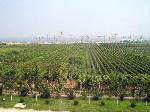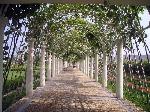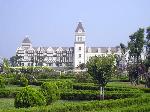- Getting around Lijiang. Dont stay in the Old Towns more than 2 days, there is nothing to do. KRISS Oct 9, 2013 05:46
- 2013 Beijing Temple Fair BENNYLAU Feb 26, 2013 03:29
- Malaysian traveling from KUL - LAX vis Shanghai PVG ZATI_DY Jan 3, 2013 20:15
Experience the Crush
- Views: 14723
- |Vote: 0 0
- |Add to Favorites
- |Recommend to Friends
The French arrived here earlier than most. As early as 1858 they had signed one of those now all too familiar one-sided treaties with the Qing Court giving them control of the small port of Dengzhou. This ancient city on the northern coast of the Shandong Peninsular, once home to China’s Ming Dynasty Naval Fleet is now the well-known city of Penglai. It wasn’t long before the move was made to the larger deep-water harbour at Chefoo where the French were soon joined by many of their European neighbours, also eager to take advantage of some unfair trade with China.
Recognizing that soil and climatic conditions were favourable for the cultivation of grapes and wine making, this information later came to the attention of the recently returned and now very wealthy Zhang Bishi, from Guangdong Province. Looking for investment opportunities in the early 1890’s this visionary man introduced the first vines to Yantai, some 30 varieties from all over Europe. Construction of the first cellars commenced in that fateful year of 1894 when nearby regions of the Shandong Peninsular fell into the hands of the Japanese.
Disasters and delays impeded construction when the initial walls collapsed and steel walls rusted. Laid down in sandy soil, close to the beach and below sea level it was almost 11 years before this unique cellar was completed. In the end a mixture of locally quarried blue stone, brick and concrete – then an exotic medium in China – was used to produce what we see today. With good drainage, a constant temperature of around 14°C and humidity between 70-80% the cellar feels very comfortable even when it is not so hot outside. With the knowledge and assistance of the French, China’s first modern winery was established.
During those years of construction Changyu laid down 1000 oak barrels imported from England and France, many of which are still in use today sporting names like TJ Boswell and Moreau. This original cellar is in the basement of the Changyu Museum in downtown Yantai. The Museum is set in spacious landscaped grounds with a relaxed setting amongst trellises of vines, flowering shrubs, an array of sculptures and a beer garden. Dionysus, the Greek god of wine features in the fountain, holding aloft the emblem of the International Vine and Wine City. Just a block back from the beach beside the Peoples Hospital it compliments the restored commercial centre of the foreign treaty settlement and is one of the cities most popular attractions.
The Museum houses a small but interesting display of the turn of the century brass brewing and fermenting equipment, along with the history of the Changyu Pioneer Wine Co. as it was then known. Other rooms house a recreation of the earlier wine making techniques, a product history display which includes Gold Medal awards won at the 1915 Panama-Pacific International Exposition as well as many subsequent awards achieved during the 110 year life of the winery. Deep in the cool dimly lit cellar with its arched ceilings and row upon row of oak casks is the wine tasting area and a winemaking workshop. All this is included in the entrance fee with a complimentary gift bottle of the Changyu Brandy, which has also been produced here for more than a century.
Traditionally, distilled spirits are the preferred drink of the Chinese, with beer at now very affordable prices running a close second these days. While Chinese wines have been around for a long time their quality and consistency has often lagged behind that of other world leaders. Still often considered a luxury beverage it is seldom the first choice at a Chinese banquet. However, China’s younger generation, many infatuated with the leisure and freedom of the western lifestyle, and with more money to burn than their parents generation are embracing new experiences. Consumption of less traditional alcoholic beverages, including wines is steadily increasing and Yantai’s local producers are poised to take advantage of this immerging trend.
In an almost endless sea of rolling hills surrounding Yantai, vineyards both old and new are sprouting with increasing vigour and the promise of a prosperous future as the awareness of and consumption of wine throughout the country increases. Brash new European style Chateau’s stand amidst this sea of vines which stretch like waves across the contryside to the rocky outcrops rising in the distance. They loom large and somewhat out of place in the Chinese landscape.
Today Changyu is a majority owned Sino-French Joint Venture with state of the art production facilities and a relatively new and impressive vineyard, cellars and fermentation vats at Chateau Changyu – Castel on the outskirts of town. From the bus window I notice women in long sleeved shirts and straw hats, well protected from the sun, tending the vines beside the road. Stepping from the bus I gaze in awe across the broad, almost empty boulevard, through the tall elegant wrought-iron gates upon the grounds of the oldest, largest and stateliest of the wineries.
The classic white chateau, in Tudor style architecture makes a grand statement, set back from the gates behind a broad expanse of lush manicured gardens. My approach is leisurely and relaxed; strolling in the shade of one of a pair of long vine-laced arbours with full ripe fruit dripping in bunches all around me. Unable to resist the temptation I make the bold assumption that sampling the fruit is mandatory. I pass a couple of men working amongst the rows of vines – an infinite variety – each carefully labelled with names like White St Peter and Royal Rose. Apart from them the grounds are quiet, deserted, basking in the morning sun.
Plump juicy bunches of fruit in soft sultana greens and the purple blush of cabinet cluster coyly amongst the broad shady leaves. Each heavily laden trellis sheltered beneath fine mesh netting. While the winery owns its own property, it grows only a small percentage of its production needs, instead contracting hundreds of local farmers to produce the tonnage it requires, thus ensuring the broader community benefits from its more than twenty percent share of this emerging domestic market.
I step up to the door of the Chateau, which opens into a large refreshingly cool showroom with sunlight streaming through the windows onto polished timber floors. I’m the only visitor this morning and after purchasing my entrance ticket I’m taken on a private tour of the complex. My guide speaks English and after she has filled me in, I ask a few questions but it quickly becomes obvious that she has memorized a script and her communication skills are limited so we make little progress in English and resort to Chinese. After the tour of this state of the art, spit and polish, stainless steel and glass winery I am ushered into the bar. Seated on a stool I’m invited to taste a couple of wineries popular vintages. While I swill, sniff and sip my samples, my young hostess answers some more of my questions about the bottles on display.
In China, the colour red symbolizes happiness and white, death, so it is no surprise that red wine consumption far outweighs that of whites. One of Changyu’s premier red vintages, bottled in sleek black, sells for a hefty Y600 per bottle. Beside me on the bar is a souvenir box set of four unique bottles - a Red Wine Vermouth, a Ginger Wine, a Riesling and a Red each with a replica label of the original Chengyu Pioneer Wine Co. Ltd. Chateau Changyu – Castel houses modern wine fermenting vats, a cellar, and a wine tasting room, a museum and a cellar door with bottles ranging in price from thirty to a thousand dollars.
This year from the September 23rd Yantai will play host to the first ‘International Festival of Yantai Wine’. This two-week festival coincides with the harvest and crushing of the grapes and runs throughout the October National Day holiday. The harvest and grape crushing season in Yantai is slowly garnering attention and popularity. With the approach of winter and the apple and grape harvests imminent, October is an ideal time to visit the region to enjoy an abundance of fresh locally grown fruit not to mention the local seafood.
Despite the age of China’s vineyards and winemaking industry, the picking and crushing of the harvest is still very much a novelty to most. Visitors to Shandong wineries can now experience the ‘crush’, that delightfully messy pressing of the grapes, and a significant ritual with every harvest. In just a few more years the Shandong Peninsular, with all her natural beauty, historical attractions and gastronomic delights may well rival areas of Europe, Australia and the US for wine tasting tours and holidays with Chateau Changyu – Castel, a proudly home grown vineyard and winery as the centrepiece.
Changyu Wine Culture Museum Y30
On the periphery of the Foreign concession next to the People’s Hospital to the east of Yantaishan.
Chateau Changyu – Castel Y30
Just beyond the Kaifaqu or Golden Beach on the road to Penglai.
Catch a local bus Y1 each way










 Copyright © 1998-2026 All rights reserved.
Copyright © 1998-2026 All rights reserved.
1.
Jun 16, 2007 18:26 Reply
WINDENERGY said:
It's strange how a place as elegant and grand as the Chateau Changyu would be so deserted on a sunny, summer day. Perhaps it's too early in the year for tourists and Sichuanese to idlely pass their time at a winery. The Chateau and the grounds look impressive.
Your story is well-researched and written and has captured my interest. I was wondering what to do over the October National Day Holiday and may go out to Yantai to sample the wine and enjoy the festival.
Thank you for sharing this story ; )